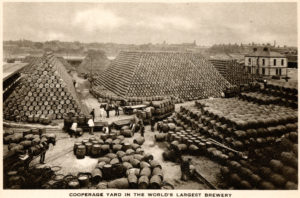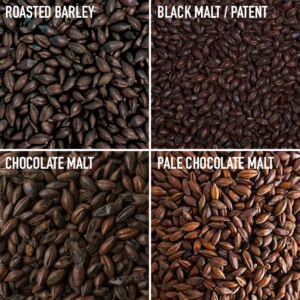![]() by Mark E. Lasbury for Indiana On Tap
by Mark E. Lasbury for Indiana On Tap
note – Originally published last winter, we’ll repeat this since it’s stout weather again, and we’ll try to get through all the stout styles in the next few weeks.
We’re amidst the dark days of craft beer. You can argue the point if you like, but the truth stands out. Even if we recognize what’s happening and how people are reacting, it’s just going to repeat itself soon. Yes, this really is the season of the stout, and people love them.
It’s certainly true that stouts are more popular in the winter, when a bigger, roastier, higher alcohol beer is what can keep you warm and happy during the cold months. But they are becoming popular in the summer now too, so the dark days of craft may be expanding to encompass the entire year….. I don’t have a problem with that.
To be an informed craft beer drinker, one who understands a little bit about what they are drinking and what differentiates one beer from another, it’s important to learn the history and characteristics of the beers you’re enjoying. This is particularly true when it comes to stouts because there are several styles within the dark genre. They have a long and storied history, and they link several parts of the world together through beer.

The stout may have been born in Dublin, but more of what we drink today has its direct roots in London. From there it traveled around the world and the family diverged to include the seven or eight different siblings that we know today. From the dry Irish to the Russian Imperial, it’s a bit hard to believe that these beers all came from the same mother, including that bastard step-child, the pastry stout. But who knows though, the pastry stout might be thought of as legitimate over time.
Most stouts in the US descend from the London porters and the English stouts that came back from Ireland, and can rightfully be considered American stouts, but the panoply of stouts taken together represent several lines of development, and together can take their seat at the head of the table as being a major driver of the fanaticism in craft beer over the last decade and a half. Indeed, most of the beers that were focuses of the early release parties and trades were stouts of one type or another – Dark Lord, Hunahpu’s, Darkness, Parabola, Abraxas, Black Tuesday…. and the barrel aging craze of the craft beer age certainly began with stouts.
Over the next few posts, we’ll talk about where stouts came from, what the various styles of stouts are now, and where they might be going in the future.
Where did stouts come from? British brewers invented the porter – that was in the early 1700s, as a new choice for drinkers besides the hoppy pale or the sweet brown ale. The porter came down on the hoppy side of the brown and on the dark and bigger body side of the pale, and was more complex due to its aging in wooden casks (called butts). It was basically a meal in a glass. This “butt beer” became a favorite of the laborers that carried luggage and cargo on the Thames riverboats, the “porters,” and butt beer those became the porter.
Over a very short time the porter became the toast of the London beer drinking community – which meant everyone. It was especially popular amongst the labor classes since it did do so much to bolster their diet (people still go on Guinness-only diets and do quite well), and as a consequence, London breweries could hardly keep up with the demand. Even after the stout made its appearance, the majority of beer being consumed in London was porter.

This led to some massive brewing companies, employing many massive vats for the making and finishing of beer. Meux & Co. was one of these large breweries; in fact it was the second largest in the city at the turn of the nineteenth century. In the afternoon of October 17th, 1814 (our son’s birthday by the way; no not the same year) it was noted that an iron band had slipped on one of the vats holding porter (that’s all they made) at their Horse Show Brewing facility, about 153,000 US gallons worth of beer in that one vat.
A slipping band wasn’t unheard of, so they noted it and wrote a message to one of the partners to have it fixed. The same guy who noted the band slippage was holding said message about 10 yards from the vat when it blew. The contacts burst out with tremendous force, destroying another vat of similar size and a few dozen hogsheads that were nearby. The resulting deluge blew out the rear wall of the brewery and flooded the slum neighborhood behind it. Eight people were killed, including several people attending an Irish wake.
Houses were destroyed and bricks from the brewery were found on roofs a few streets away. The worker who was standing nearby was unhurt, and he testified at the inquest as to the fact that bands slipped 3-4 times a year without consequence until now. The coroner ruled the incident an act of God, and the brewery was not forced to pay damages; the watchmen even made a few pounds by charging people to come in to look at the damage. The brewery did lose over 400,000 US gallons of porter – that’s about the same volume as an Olympic sized swimming pool all released at once. They would have gone bankrupt if they hadn’t been given a special dispensation to avoid taxes on the lost beer.
That was The Great London Beer Flood and speaks to how popular porter was, but by the time this occurred, porter had already moved across to Ireland and begun its transformation into stout. Brewers in Ireland had quickly picked up on the London porter and gave it their own spin, including a later, bigger version with a drier taste and slightly more roast to the grist, but by that time the new beer style had made its way back to London.

This was indeed the start of the “stout porter” and came about in part just by using less water in a porter recipe. Guinness was an original for these stout porters, first brewed in 1778. However, Guinness isn’t really a big bodied stout, it continues to this day to be an early version of a dry Irish stout, a lighter body version of the beers that developed in England after the dry Irish stout made its way back across the Irish Sea to London.
The word stout was (and is) a synonym for “strong,” so many styles of beer had “stout” versions, stout pales (which became the barleywines over time), stout browns, etc. For many years the stout porter and the porter were all but the same thing apart from a bit more alcohol and a bit more body in the stout version, but Guinness started to move the two further apart. Indeed, as porters and stout porters in both London and Dublin diverged from one another over the next 100 years or so, the stout porter dropped the word “porter,” took on a life of it’s own.
Never satisfied with taking one step when you can take four (still a factor in craft beer today), London brewers started to make their version of the stout, with darker malts than Guinness (take a look at your Guinness in the light, it’s really dark ruby red in color). When the stout moved across the Atlantic to the US, this tendency to use roastier, darker malts came with it, and it grew from there. But that isn’t to say the English stout stagnated. It developed as well – right into the Russian Imperial Stout.
Now that we have a very basic history of how the stout came about, we can start to dissect the various types of stouts. Let’s start with the mother of all stouts, the Irish Dry Stout, and in the next articles we’ll cover the rest of the stouts. When and why they each came about will help us understand them, and the characteristics of each style will help you decide which are your favorites.
Irish Dry Stout. As noted above, the Irish dry stout was really the first discernable move away from the porter that had made it’s way over from London. In the beginning, and pretty much still today, the Irish dry stout can be considered a stout or strong porter. In fact, the Irish Dry stouts of today are small as compared to the originals when it comes to alcohol, but more on that below.

As we intimated above, Arthur Guinness was one of the first to strengthen to porter, in the brewery at St. James Gate he purchased in 1759 (he got a 9000 year lease for £45/yr., about $52 in today’s dollars) and sent it back to London. However, he had started by brewing Dublin ales, and then switched to doing only porters by 1799, including the West Indian Porter (in 1801) that now has its best parallel in the Guinness Foreign Extra Stout. It wasn’t until 1810 that he started producing stout porters.
It was in 1819 that black patent malt was produced by Daniel Wheeler in his malt kiln and this intrigues Guinness. They started using only patent malt and pale malt, and got a roasty stout porter. Over time he used more darker malts and some unmalted roast barley, and the Irish dry stout was born.
The early Irish dry stouts like the original Guinness made its way back across to England, and for many years, London stouts were indistinguishable from Irish dry stouts. With time though, different strengths of stouts were developed, just like the previous experience with differing strengths of porters. Names like common porter, best porter, single stout, extra stout, and imperial stout were born over time and through the necessity to please the various drinking populations.
By 1900, the stout had supplanted the porter by a wide margin, and big beers were the norm – big in roast, big in body, and big in alcohol. However, things were changing. This style of beer, as were many others, was a victim of the massive tax increases on alcohol percentage, safety concerns, and wartime need for sober soldiers. They moved to lower gravity over time, so stout came to mean more a roasty black beer, rather than a strong beer. Take another look at your Guinness bottle, it drinks like a big beer, but it only clocks in at 4.2% ABV. Other versions of Guinness have more alcohol, but the Guinness stout that most people have drinks bigger than it really is.
Now we know why it’s an Irish stout, but why is it “dry?” There are a couple of reasons, one historical and one based in the grist of the dry stout. In England (and America) the stout that came from Ireland and hung around for decades came to be challenged by the sweet stout and the oatmeal stout. We’ll talk about these stouts in upcoming posts, but suffice it to say that they had/have a sweeter taste than Irish stouts. To differentiate between them, the Irish stout was called “dry,” ie. less sweet.

The second reason is because they really are a bit drier. Irish stouts can use a variety of malts and grains, but they historically (and even now) use a decent portion of roasted barley (un-malted). Using about 7% will give the dark color, with higher amounts turning it more opaque and adding more roast flavor. The use of some un-malted barely adds a bit of fermentable sugar and unfermentable sugar, but lowers the overall level of sugar as compared to using malted barley. Plus, Irish dry stouts traditionally use very little or no amber and chocolate malts. These have higher percentages of unfermentable sugar and therefore leave more sugar in the finished beer (taste sweeter).
Irish dry stouts are most often (you can’t make definitive statements because every brewer has the right to innovate) black, opaque, and have a coffee or unsweetened chocolate kind of aroma. The roast provides the majority of the flavor, with hop aroma and flavor being low, the same with fruity esters. The roast bitterness will be the primary finishing flavor. The roast imparts a slight acidity, so they may have a bit of a bite up front. The head can be various colors based on the malts used – roasted barley giving the whitest head of the dark malts.
ABV can range widely, but traditional versions will be in the 4.2-5.3% range – American versions will likely be higher and have more hop flavor and aroma. There can be a graininess from the roasted barley and a medium to medium-light body. Finally, they will have some creaminess and often use low to moderate levels of carbonation. Build beer like that and you’ll have an Irish dry stout (not counting all the tricks one can play with water and carbonate, etc).
Indiana examples. Countess Markievicz from Hop River Brewing, Bogside from Bier Brewery, Rad Bod from Bad Dad Brewing, North Street Stout from Four Day Ray Brewing, Quinn from Backstep Brewing, Kiss Me, I’m Roasty from Traders Brewing, Donegal from Mind Over Mash Brewing, Digby’s from Lafayette Brewing, Fuel Cell from Tin Man Brewing Kokomo, Gaelic from Rad Brewing, Nick Egan’s from Redemption Alewerks, McRyan O’Bryan from Quaff On! Brewing, Rover Irish Stout from People’s Brewing, Irish Fog from Goshen Brewing, Black Sun from 3 Floyds Brewing, and Ring of Dingle from Sun King Brewing.
Next time we’ll look at the sweet stout and perhaps a couple more.
banner image credit: Craft Beer & Brewing
